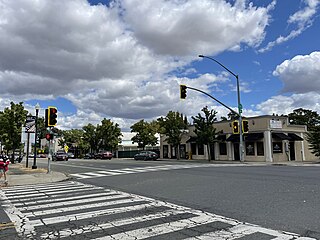
Middletown is a census-designated place (CDP) in Lake County, California, United States. Its population was 725 at the 2020 census down from 1,323 at the 2010 census, which was up slightly from 1,020 at the 2000 census. Middletown was given its name because it is halfway between Lower Lake and Calistoga, which is 17 miles (27 km) to the south. The town was severely damaged by the 2015 Valley Fire.

The 2007 California wildfire season saw at least 9,093 separate wildfires that charred 1,520,362 acres (6,152.69 km2) of land. Thirty of those wildfires were part of the Fall 2007 California firestorm, which burned approximately 972,147 acres of land from Santa Barbara County to the U.S.–Mexico border. At the peak of the wildfire activity in October 2007, the raging wildfires were visible from space.

The Witch Creek Fire, also known as the Witch Fire, was the second-largest wildfire of the 2007 California wildfire season, burning 197,990 acres (801 km2) of land in San Diego County. Fanned by powerful Santa Ana winds, the Witch Creek Fire rapidly spread westward and consumed large portions of San Diego County. During its duration, flames reached 80 to 100 feet high, and the Witch Fire exhibited the characteristics of a firestorm at its height.
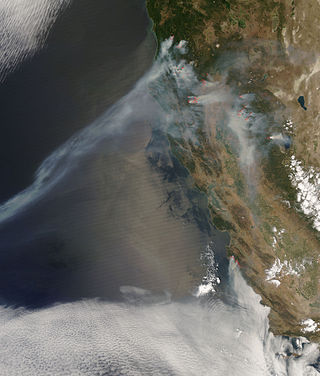
The 2008 California wildfire season was one of the most devastating in the state of the 21st century. While 6,255 fires occurred, about two-thirds as many as in 2007, the total area burned— 1,593,690 acres —far exceeded that of previous years.

2014 saw several notable wildfires igniting in California, especially during the month of May, when multiple fires were ablaze concurrently in Southern California, and during September, when several massive wildfires were burning in Northern California. In the context of the 2012–13 North American drought, as well as powerful Santa Ana winds, weather conditions were ideal for wildfires. A total of 7,865 wildfires ignited throughout the year, which burned at least 625,540 acres (2,531.5 km2) of land. The wildfires caused a total of 146 injuries and 2 fatalities, in addition to causing at least $204.05 million in damage.
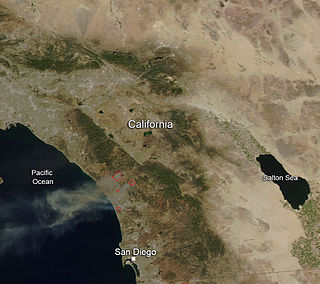
The May 2014 San Diego County wildfires were a swarm of 20 wildfires that erupted during May 2014, in San Diego County, California, during severe Santa Ana Wind conditions, historic drought conditions, and a heat wave. The main event during mid-May was preceded by a precursor fire that ignited on May 5. The Bernardo Fire has been declared accidental, and officials believe the Cocos Fire was intentionally set. The causes of the other fires are still under investigation by multiple agencies, and a joint task force was formed to coordinate the investigations and facilitate communications. Six injuries and one fire-related fatality were reported.

The October 2007 California wildfires, also known as the Fall 2007 California firestorm, were a series of about thirty wildfires that began igniting across Southern California on October 20. At least 1,500 homes were destroyed and approximately 972,147 acres of land was burned from Santa Barbara County to the U.S.–Mexico border, surpassing the October 2003 California wildfires in scope, which were estimated to have burned 800,000 acres (3,200 km2). The wildfires killed a total of 14 people, with nine of them dying directly from the fires; 160 others were injured, including at least 124 firefighters. At their height, the raging fires were visible from space. These fires included the vast majority of the largest and deadliest wildfires of the 2007 California wildfire season. The only wildfire in 2007 that surpassed any of the individual October 2007 fires in size was the Zaca Fire.

The 2005 California wildfires were a series of wildfires that were active in the state of California during the year 2005. In total, 7,162 fires burned 222,538 acres (900.58 km2) of land.

In 2016, a total of 7,349 fires had burned an area 669,534 acres (2,709.51 km2) in California, according to the California Department of Forestry and Fire Protection.

In terms of property damage, 2017 was the most destructive wildfire season on record in California at the time, surpassed by only the 2018 season and the 2020 season, with a total of 9,560 fires burning 1,548,429 acres (6,266.27 km2) of land, according to the California Department of Forestry and Fire Protection, including five of the 20 most destructive wildland-urban interface fires in the state's history. Throughout 2017, the fires destroyed or damaged more than 10,000 structures in the state, a higher tally than the previous nine years combined. State data showed that the large wildfires killed 47 people – 45 civilians and 2 firefighters – almost higher than the previous 10 years combined. The total property damage and total amount of burned land were both surpassed by the 2018 California wildfires.

The Tubbs Fire was a wildfire in Northern California during October 2017. At the time, the Tubbs Fire was the most destructive wildfire in California history, burning parts of Napa, Sonoma, and Lake counties, inflicting its greatest losses in the city of Santa Rosa. Its destructiveness was surpassed only a year later by the Camp Fire of 2018. The Tubbs Fire was one of more than a dozen large fires that broke out in early October 2017, which were simultaneously burning in eight Northern California counties, in what was called the "Northern California firestorm". By the time of its containment on October 31, the fire was estimated to have burned 36,810 acres (149 km2); at least 22 people were believed to have been killed in Sonoma County by the fire.

The October 2017 Northern California wildfires, also known as the Northern California firestorm, North Bay Fires, and the Wine Country Fires were a series of 250 wildfires that started burning across the state of California, United States, beginning in early October. Twenty-one became major fires that burned at least 245,000 acres (99,148 ha).

The 2018 wildfire season was the deadliest and most destructive wildfire season in California history. It was also the largest on record at the time, now third after the 2020 and 2021 California wildfire seasons. In 2018, there were a total of 103 confirmed fatalities, 24,226 structures damaged or destroyed, and 8,527 fires burning 1,975,086 acres (799,289 ha), about 2% of the state's 100 million acres of land. Through the end of August 2018, Cal Fire alone spent $432 million on operations. The catastrophic Camp Fire alone killed at least 85 people, destroyed 18,804 buildings and caused $16.5 billion in property damage, while overall the fires resulted in at least $26.347 billion in property damage and firefighting costs, including $25.4 billion in property damage and $947 million in fire suppression costs.

The Pawnee Fire was a large wildfire that burned in Spring Valley in Lake County, California, in the United States. The fire started on June 23, 2018, and quickly expanded overnight, destroying 12 structures, and causing the evacuation of the entire Spring Valley area. It destroyed 22 structures, damaged six structures, and burned a total of 15,185 acres (61 km2) before it was fully contained on July 8, 2018. A Cal Fire investigation determined in April 2019 the cause of the fire was target shooting.

The Carr Fire was a large wildfire that burned in Shasta and Trinity Counties in California, United States. The fire burned 229,651 acres, before it was 100% contained late on August 30, 2018. The Carr Fire destroyed at least 1,604 structures while damaging 277 others, becoming at the time the sixth-most destructive fire in California history, as well as the fourteenth-largest wildfire recorded in modern California history. The Carr Fire cost over $1.659 billion in damages, including $1.5 billion in insured losses and more than $158.7 million in suppression costs. The fire destroyed multiple towns around Whiskeytown Lake. At its height, the fire engaged as many as 4,766 personnel from multiple agencies. The fire was reported on the afternoon of July 23, 2018, near the intersection of Highway 299 and Carr Powerhouse Road, at mile marker 9, in the Whiskeytown district of the Whiskeytown–Shasta–Trinity National Recreation Area. Coincidental to the name of the incident, the fire was started when a flat tire on a vehicle caused the wheel's rim to scrape against the asphalt, creating sparks that set off the fire.
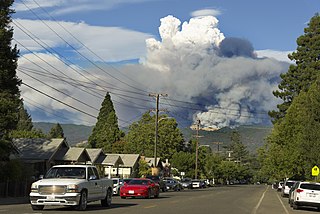
The Mendocino Complex Fire was a large complex of wildfires that burned in northern California for more than three months in 2018. It consisted of two wildfires, the River Fire and Ranch Fire, which burned in Mendocino, Lake, Colusa, and Glenn Counties in the U.S. State of California, with the Ranch Fire being California's single-largest recorded wildfire at the time until the August Complex fire in 2020. The Ranch Fire burned eight miles northeast of Ukiah, and the River Fire burned six miles north of Hopland, to the south of the larger Ranch Fire. First reported on July 27, 2018, both fires burned a combined total of 459,123 acres (1,858 km2), before they were collectively 100% contained on September 18, though hotspots persisted until the complex was fully brought under control on January 4, 2019. The Ranch Fire alone burned 410,203 acres (1,660 km2), making it the largest wildfire in modern California history at the time until the August Complex fire that occurred in 2020. The Ranch Fire also surpassed the size of the 315,577-acre Rush Fire, which burned across California and Nevada, as well as the Santiago Canyon Fire of 1889, which was previously believed to have been California's all-time largest wildfire.
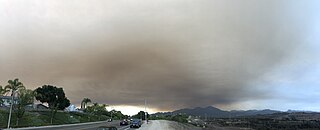
The Holy Fire was a wildfire that burned in the Cleveland National Forest in Orange and Riverside Counties, California. The wildfire started on August 6, 2018, at around 1:15 PM PDT, in the vicinity of Trabuco Canyon. A suspected arsonist was booked into the Orange County jail in Santa Ana, California but found not guilty in 2023. The blaze burned 23,136 acres (94 km2) and destroyed 18 buildings, before it was fully contained on September 13, 2018. While the fire was actively spreading in early and mid-August, residents of the nearby cities of Corona, Temescal Valley, and Lake Elsinore were placed under evacuation orders.

The Butts Fire was a wildfire in Napa County north of Pope Valley, and 10 miles west of Lake Berryessa, California in the United States. The fire was reported on July 1, 2014 and was contained on July 10, after burning an estimated 4,300 acres (17 km2). The fire, dubbed after Butts Canyon in the Pope Valley area, threatened more than 300 homes at its peak, and lead to the closure of Butts Canyon Road. The cause of the Butts fire remains under investigation. The fire also subsequently destroyed 2 homes, 7 outbuildings and killed 2 civilians. At the fires peak, 1,682 fire personnel, 101 fire engines, 60 fire crews, 10 bulldozers, nine helicopters, and four air tankers were battling the inferno.

The LNU Lightning Complex fires were a large complex of wildfires that burned during the 2020 California wildfire season across much of the Wine Country area of Northern California – Lake, Napa, Sonoma, Solano, and Yolo Counties, from August 17 to October 2, 2020. The complex was composed of numerous lightning-sparked fires, most of which were small. While they ignited separately from each other, the Hennessey Fire eventually grew to merge with the Gamble, Green, Markley, Spanish, and Morgan fires, scorching 192,000 acres (777 km2) by itself, for a total burn area of 363,220 acres (1,470 km2) in the complex. The fire, which burned in the hills surrounding several large cities, such as Fairfield, Napa, and Vacaville, destroyed 1,491 structures and damaged a further 232. In all, six people were killed and another five injured. The LNU Lightning Complex is the seventh-largest wildfire in the recorded history of California.





















